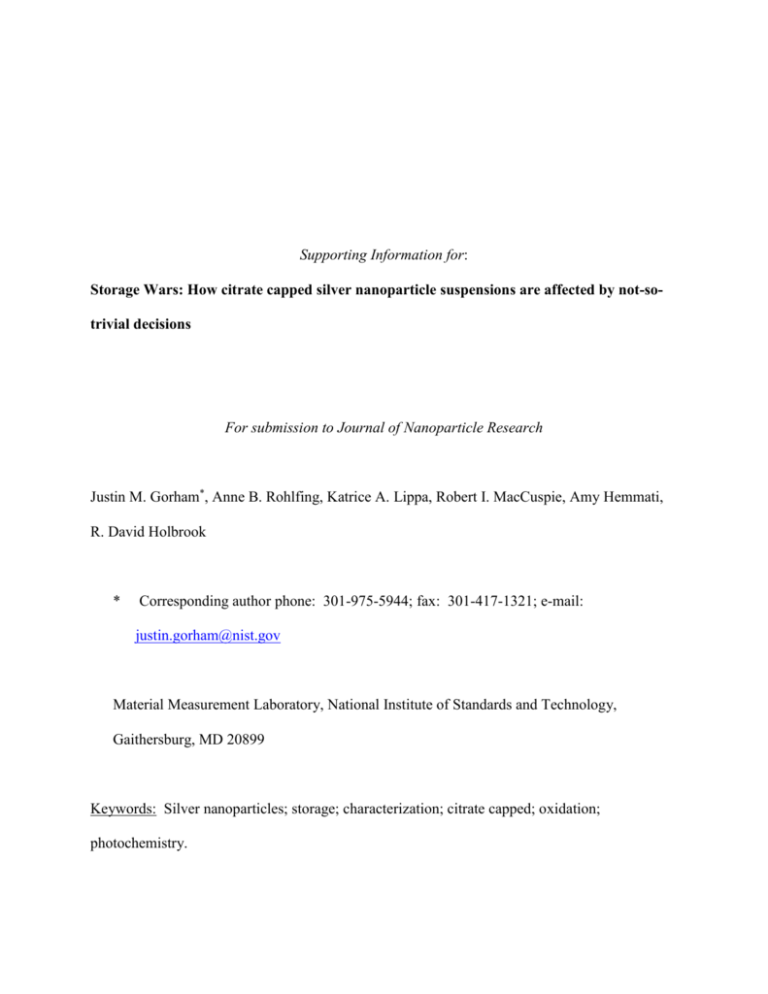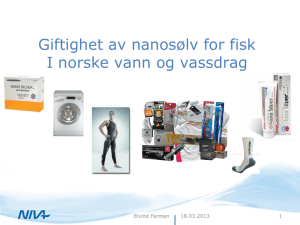Supporting Information for: Storage Wars: How citrate capped silver
advertisement

Supporting Information for: Storage Wars: How citrate capped silver nanoparticle suspensions are affected by not-sotrivial decisions For submission to Journal of Nanoparticle Research Justin M. Gorham*, Anne B. Rohlfing, Katrice A. Lippa, Robert I. MacCuspie, Amy Hemmati, R. David Holbrook * Corresponding author phone: 301-975-5944; fax: 301-417-1321; e-mail: justin.gorham@nist.gov Material Measurement Laboratory, National Institute of Standards and Technology, Gaithersburg, MD 20899 Keywords: Silver nanoparticles; storage; characterization; citrate capped; oxidation; photochemistry. Silver nanoparticle synthesis Approximately 3.250 L of milli-Q water was heated on a stir plate to > 90 ˚ C. In series, 0.298 g of silver nitrate and 1.597 g of trisodium citrate dihydate (henceforth referred to as ‘citrate’) (209139 and S4641, respectively, Sigma Aldrich, St. Louis, MO) were added to the heated water and allowed to dissolve under constant stirring. Once dissolved, a solution of freshly prepared, 0.113 g of sodium borohydride (S9125, Sigma Aldrich, St. Louis, MO) in 31.00 mL of milli-Q water was added drop wise under constant stirring to the heated solution, resulting in the characteristic color change from clear to dark yellow. After the AgNP solution was stirred for 30 min, the beaker was covered and allowed to cool to room temperature. Instrumentation for additional stock characterization X-ray photoelectron spectroscopy (XPS) was acquired on a Kratos Axis Ultra DLD (Chestnut Ridge, NY) to confirm the presence of metallic silver in the AgNPs. Secondary electron microscopy (SEM) was acquired on (JEOL 8500-F, Peabody, MA) and Energy dispersive spectroscopy (EDS) (Bruker, Madison, WI) to confirm the presence of nanoparticles composed of silver. DLS Analysis procedures and interpretation As stated in the main text, the mean of no less than four measurements of Z average were employed in calculating the intensity based average particle diameter for the AgNP suspensions, with one standard deviation about the mean. Data analysis was carried out automatically by the Zetasizer software version 7.01 (Malvern, Westborough, MA). The cumulants analysis was carried out using a quadratic weighting scheme and a 3rd order fit excluding the lower 10% of the correllogram. Due to the fact that there was (a) a small fraction of < 5 nm particles as part of the initial suspension as observed in the DLS (<5%), (b) multimodal, polydisperse distribution of particle diameters as a result of various storage conditions, and/or (c) low concentrations of silver particles in suspension (e.g. 0.36 mg/L AgNP suspensions), the error reports associated with the cumulant analyses were reported to be high. Thus, the average particle diameters should be taken as a qualitative guide of how the particle size distribution changed over time, rather than a quantitative measure of a single particle diameter. These values by themselves cannot be used to state that the cause of a particle size change is due solely to any specific phenomenon, such as dissolution, ripening, or agglomeration, and must be used in conjunction with other techniques such as the reported optical spectroscopy. Initial Stock Characterization UV-vis spectra and DLS measurements were acquired to measure the SPR peak position and the average diameter, respectively. Additional techniques confirmed the chemical and structural characteristics expected from AgNP suspensions. Scanning electron microscopy (SEM) images were collected to confirm the presence of nanoscale particles and and Energy Dispersive X-ray Spectroscopy (EDS) was performed to confirm that they were composed of silver (SI Figure S1). XPS confirmed that the silver in the suspension was metallic rather than oxidized by calculating the modified Auger parameter (α') (SI Figure S2). This was accomplished by acquiring spectra for both the Ag (3d) photoelectron region and the Ag (MNN) Auger transition (See SI Figure S2) and combining these two spectral features into the following equation [1]: α' = BE Ag 3d (5/2) + KE Ag MNN where the binding energy of the Ag (3d5/2) peak (BE Ag 3d (5/2)), or 368.3 eV, was added to the kinetic energy of the Ag (MNN) peak, (KE Ag MNN), or 368.1 eV. A sum of 726.4 eV which was comparable to the value measured for a silver foil of 726.1 eV and previously observed in the literature [2]. 1. 2. Briggs, D. and M.P. Seah, Practical surface analysis. 2nd ed. 1990, Chichester ; New York: Wiley. Gorham, J.M., et al., UV-induced photochemical transformations of citrate-capped silver nanoparticle suspensions. Journal of Nanoparticle Research, 2012. 14(10). Ag L Figure S1: SEM image of the native AgNP suspensions prior to storage. EDS provided to confirm the presence of silver in single particle’s and aggregates while none is present on the clean substrate. For EDS, the substrate is represented by Area 4.5, single particle is represented by 4.4 and the aggregate by 4.1. The image is 438 nm x 329 nm. Figure S2: XPS analysis of the initial, stock AgNP suspension (top) and three reference samples for silver foil, silver oxide and silver sulfide. The dashed lines represent the BE and KE peak maximums for metallic silver. Additionally,α’ values are calculated for each sample to the right and demonstrate that the AgNPs were more metallic. Figure S3: Select UV-vis spectra for all AgNP suspensions stored over 104 d under light shielded and air purged conditions. The SPR at 389 nm decreased by the largest percentage and at the fastest rate at low AgNP and low relative citrate concentrations. Figure S4: Select UV-vis spectra for all AgNP suspensions stored over 104 d under light exposure and air purged conditions. The SPR at 389 nm decreased and, occasionally, higher wavelengths increased with increasing storage time. Dark A 1 C 0 0.36 mg/L H 1 1 1.0 0.9 2.88 mg/L 0.8 0 F 1 2.88 mg/L I 1 1.0 0 10.8 mg/L 0.9 0 20 40 60 80 100 Storage (d) 0 10.8 mg/L 0 20 40 60 80 100 Storage (d) Figure S5: Graphical representation of all 18 air purged AgNP suspensions for 104 d of storage as monitored by the normalized SPR absorbance at 389 nm under dark (A, B and C) and laboratory light exposed (D, E and F) conditions. Each of the six plots consists of AgNP suspensions of a constant AgNP concentration and all three different relative citrate (relative citrate concentration legend: 0.11; 0.37; 0.87). Stability (t97 % in days) 0.36 mg/L E 0 G 1 Abs389 (normalized) B Abs389 (normalized) 0 Light D 10 8 6 4 2 0 0.36 mg/L 100 80 60 40 20 0 2.88 mg/L 100 80 60 40 20 0 10.8 mg/L Mag 10x 0.11 0.37 value Da Li 0.87 Figure S6: Select UV-vis spectra for all AgNP suspensions stored over 104 d under light shielded and nitrogen purged conditions. The SPR at 389 nm decreased by the largest percentage and at the fastest rate at low AgNP and low relative citrate concentrations. Figure S7: Select UV-vis spectra for all AgNP suspensions stored over 104 d under light exposure and nitrogen purged conditions. The SPR at 389 nm decreased and, occasionally, higher wavelengths increased with increasing storage time. Dark A C E 1.0 0.9 2.88 mg/L 0.8 F 1 0 0.36 mg/L Mag 10x 100 80 60 40 20 0 2.88 mg/L 100 80 60 40 20 0 10.8 mg/L 0.36 mg/L H 1 0 2.88 mg/L I 1 1.0 0 10 8 6 4 2 0 10.8 mg/L 0.9 0 20 40 60 80 100 Storage (d) 0 10.8 mg/L 0 20 40 60 80 100 Storage (d) Figure S8: Graphical representation of all 18 nitrogen purged AgNP suspensions for the full 104 d of storage were monitored by the normalized SPR absorbance at 389 nm under dark (A, B and C) and laboratory light exposed (D, E and F) conditions. Each of the six plots consists of suspensions at constant AgNP concentration with all three different relative citrate concentrations (relative citrate concentration legend: 0.11; 0.37; 0.87). Stability (t97% in days) 0.36 mg/L 1 0 G 1 Abs389 (normalized) Abs389 (normalized) B 0 Light D 1 0.11 Dark Light 0.37 0.87 value Figure S9: Graphical representation of the evolution of the broadening and size increases associated with the nine air purged, and dark AgNP suspensions for the full 104 d of storage as monitored by the SPR normalized absorbance at a) 455 nm and b) 650 nm. Each of the six plots consists of suspensions of a constant AgNP concentration at three different relative citrate concentrations. (relative citrate concentration legend: 0.11; 0.37; 0.87) Figure S10: Graphical representation of the evolution of the size increases associated with the nine air purged, and light exposed AgNP suspensions for the full 104 d of storage as monitored by the SPR normalized absorbance at (a) 455 nm and (b) 650 nm. Each of the six plots consists of suspensions at constant AgNP concentration at three different relative citrate concentrations. (relative citrate concentration legend: 0.11; 0.37; 0.87) Figure S11: Graphical representation of the evolution of the broadening and size increases associated with the nine nitrogen purged, and dark AgNP suspensions for the full 104 d of storage as monitored by the SPR normalized absorbance at a) 455 nm and b) 650 nm. Each of the six plots consists of suspensions of a constant AgNP concentration at three different relative citrate concentrations. (relative citrate concentration legend: 0.11; 0.37; 0.87) Figure S12: Graphical representation of the evolution of the size increases associated with the nine, nitrogen purged, and light exposed AgNP suspensions for the full 104 d of storage were monitored by the SPR normalized absorbance at a) 455 nm and b) 650 nm. Each of the six plots consists of suspensions at a constant AgNP concentration with all three different relative citrate concentrations. (relative citrate concentration legend: 0.11; 0.37; 0.87) Table S1: DLS measured average diameters and standard deviations for the three relative citrate concentrations and all 18 air purged AgNP suspensions after 104 d of storage. Table S2: DLS measured average diameter and standard deviation for the three initial citrate: silver ratios and all 18 nitrogen purged AgNP suspensions after 104 d of storage. Figure S13: Select DLS measurements for all air purged suspensions in the dark. The average AgNP diameter always increased for low silver concentrations, decreased followed by increase for middle silver concentrations, and varied for high silver concentrations 200 B) 300 400 500 600 2.88 mg/L; =0.37; N2; light 300 800 Day 0 Day 39 Supernatant Supernatant + NaBH4 Absorbance 200 700 400 500 (nm) 600 700 800 Figure S14: Results from NaBH4 testing for the presence of oxidized silver with UV-vis spectroscopy represents the change between day 0 (blue) and day 36 (green) of storage for nitrogen purged, light exposed 4 mg/L AgNPs with a σ value of 0.37. After centrifuging, the supernatant was measured alone (black) and with the addition to NaBH4 (red) to reduce any oxidized silver present. Figure S15: 1H-NMR reference spectra of observed organic compounds in water (with 10% D2O). (From top to bottom) citrate methylene protons are observed as a quartet, acetoacetate methylene and methyl protons as 2 single peaks, acetone two methyl protons as a single peak, malonate methylene protons as a single peak and acetate methyl protons as a single peak.





